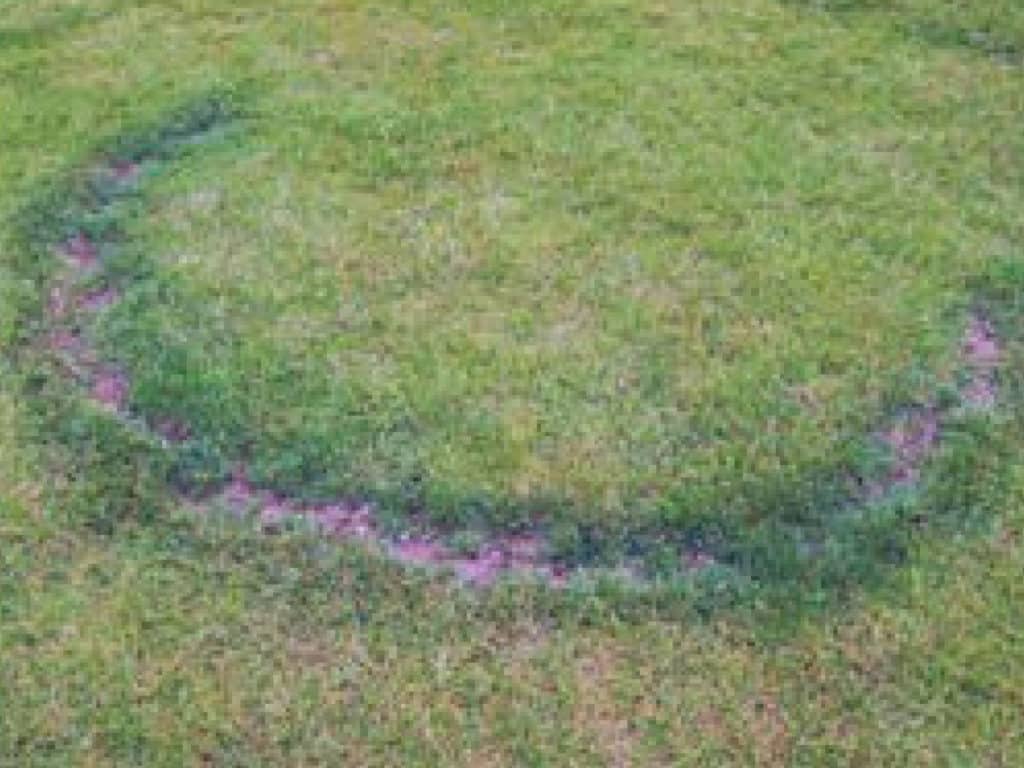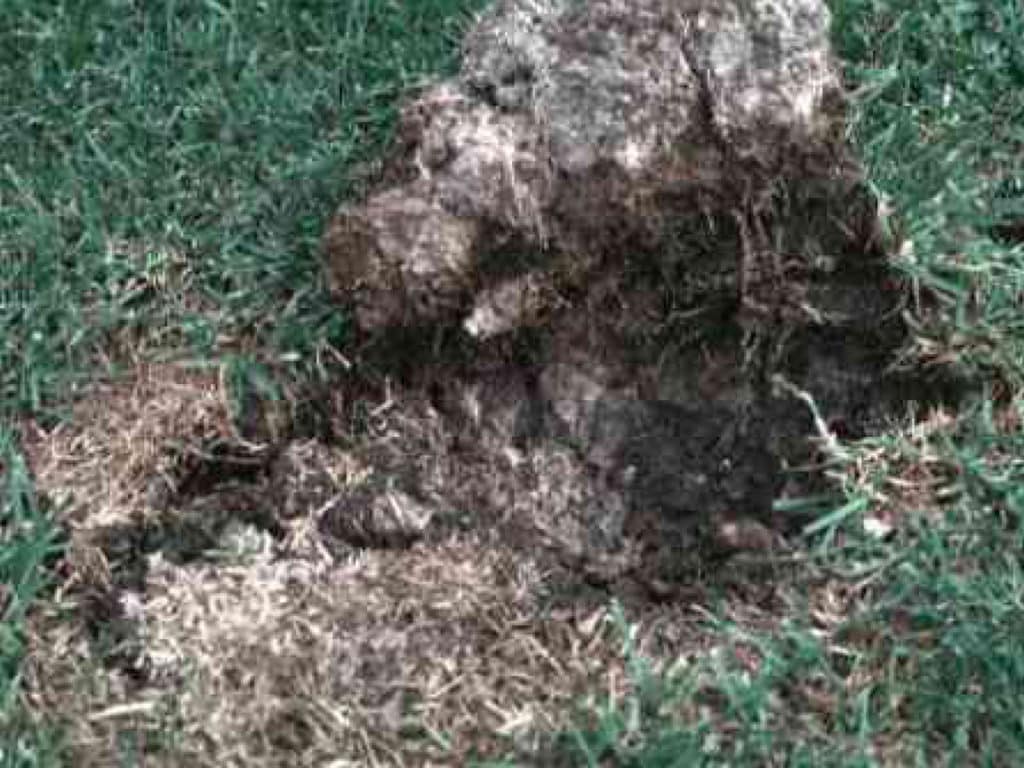

What is a Fairy Ring?
Fairy Rings are complex fungal related lawn problems. They present themselves as rings of either dead grass, green healthy grass and/or mushrooms. They are caused by many different types of fungus, but the three main type of fairy ring causing fungus are often categorised in to three main types:
Type 1
Type I fairy rings are the most common type of fairy ring in gardens throughout the UK. The rings have a zone of dead grass just inside a zone of dark green grass. Weeds often invade the dead zone. The causal fungus is Marasmius oreades.


Type 1 fairy rings are defined as those that cause loss of turf cover through the creation of hydrophobic (water repellent) conditions. The problem usually occurs during early summer and autumn when soil conditions and mild temperatures are most favourable. The most noticeable feature of this particular disease is a clear ring of dead/dying grass.
This dead zone is surrounded on the inside and outside by stimulated lush green grass, a direct result of the mycelium in the soil, and may also contain some small mushrooms. As this mycelium is extremely hydrophobic, any water applied will not infiltrate the surface or reach the root system in the affected area.




The fungus, Marasmius oreades, is at its most dense under the bare areas and can be up to 1m deep. As a consequence, the plant becomes stressed and dies leaving a characteristic bare patch for the invasion of other turf related problems such as weeds, algae and moss.
The lush green growth around the dead zone is a result of the release of nitrogen from the organic matter in the thatch, and soil below, which is caused by saprobiotic and nitrifying bacteria within the fairy ring.


Type 2
Type II rings have only a band of dark green turf, with or without mushrooms present in the band. The causal fungus is Scleroderma & Lycoperdon spp
Type 2 rings are those that produce a stimulated ring of grass growth. This is obviously most noticeable in weak or stressed turf. They do not cause any direct damage to the turf but produce white puff balls.


Type 2 fairy rings are usually confined to the thatch layer, whilst lush green growth is produced in the same way as with type 1 fairy rings. A type 2 ring has a marked effect on the visual quality of the infected area, but does not harm the individual grass plants.
Type 3
Type 3 fairy rings do not exhibit a dead zone or a dark green zone, but a ring of mushrooms is present. The causal fungus is Hygrophorus & Psilocybe spp
Type 3 fairy rings are those that produce a stimulated ring of grass growth. This is obviously most noticeable in weak or stressed turf. They do not cause any direct damage to the turf but produce white puff balls.


What causes a fairy ring?
Just like any other fungus, the hyphae can be present in the soil for a long time and lay dormant. It is only when conditions become favourable that the disease starts to form and affect the lawn. We often see the start of a fairy ring near to areas where trees (especially fruit trees) have been cut down. As the fungus starts to decompose the roots of the dying tree, the fungus gains strength and forms in to the associated disease..
How can I get rid of fairy rings?
Fairy rings are very complex disorders, and they can appear on any lawn and at any time. Some of the world’s most prize winning lawns and sports pitches have been or are affected by fairy rings. As with any fungal disorder, good cultural practices will always help, but due to the complexity of fairy rings, it is not always possible to deter them.
Cultural Methods
The only cultural option is total removal of the affected soil. Removal is the most labour intensive method, and causes the most disruption to the lawn. It is also the most ineffective.
The fairy ring hyphae can sometimes reach beyond 1 metre deep in to the soil. Furthermore, the hyphae can also stretch out beyond one metre of the outer edge of the fairy ring itself. Therefore, any attempt to remove and replace the affected soil must include an area 1 metre beyond the ring itself. And, to ensure we remove enough of the affected soil, we must also remove a depth of 2 metres.
Let’s take an example of this process. The diagram below shows the area to be marked out prior to removal.


Removing a circle of soil may seem easy enough, but due to the machinery you would need to use, it would probably be more time consuming than it would to remove a square.
The fairy ring in the diagram has a two metre diameter. At the most outer edge, the diameter of the square that needs to be marked out is 4 metres. This gives an area of 4 x 4 metres, or 16sqm. Now let’s calculate the amount of soil that would require removing, which is calculated by multiplying the square metres of the marked out square by the depth of the area to be removed. This is 16sqm x 2 metres deep. This equals 32 cubic metres of soil. Now let’s consider the fact that 1 cubic metre of soil weighs around 1.5 metric tons. The amount of soil required for the removal is 48 tons. The equivalent of almost one lorry load of soil. Don’t forget, the soil needs to be replaced by 48 tons of fresh soil!
Removing the soil presents further complications. Fungus is very efficient at reproducing itself. As we remove the soil from the affected area there is no way of controlling the amount of microscopic hyphae that will inevitably fall on to other areas of the lawn as the affected soil is transported over it. This will only lead to further fairy rings forming in other locations.
Control Methods – The Recommended Green Man Lawn Care Approach
Green Man Lawn Care offers a control method that is designed to control the growth of the fairy ring using a specialist fungicide, combined with other professional lawn care applications and techniques to help improve the health of the turf in the affected areas.
The main issue of Fairy Rings is the unsightly ring that it creates. As the ring contains hydrophobic soil (see above), a Fairy Ring treatment also improves the soil’s ability to absorb water and allow grass to grow. It is very difficult to stop the mushrooms growing in the ring, especially if conditions are good for regular fungal/mushroom growth.
It should be noted that controlling Fairy Rings is difficult and it is unlikely that one or two treatments will control the fungus to the extent that it completely disappears.
Will a fairy ring disappear on its own?
As fairy rings grow bigger and bigger each year, it is possible for the fairy ring to grow beyond the boundaries of a garden.
